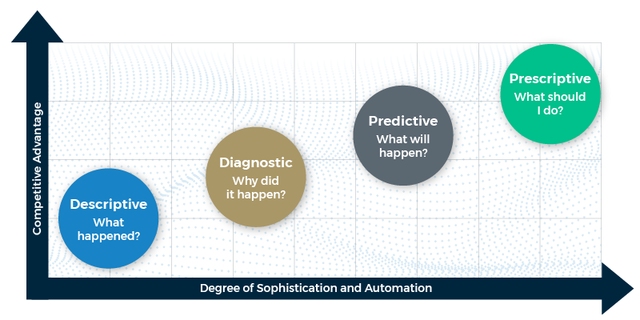In This Article
Table of Contents
What Is Data Analytics?
Data analytics is the process of exploring, transforming, and analyzing data to identify trends and patterns that reveal meaningful insights and building efficiencies that support decision-making. A modern data analytics strategy empowers systems and organizations to act based on real-time, automated analytics, ensuring impactful, immediate outcomes.
The Data Analytics Process
The data analytics process is built on multiple steps and phases. Learnings from a later phase might require moving backwards and re-working an earlier phase, making it a more cyclical rather than linear journey. Most importantly, successful data analytics processes are dependent on repeatability and automation between each of these steps.
The data analytics process is best broken down into the following steps and phases:

Types of Data Analytics

There are several different types of data analytics. They are:
- Descriptive analytics: Answers the question “What happened?” (What were our sales for the past week?)
- Diagnostic analytics: Answers the question “Why did this happen?” (Why did our sales increase from the previous week?)
- Predictive analytics: Answers the question “What will happen?” (What do we think our same store sales will be during the holiday season?)
- Prescriptive analytics: Answers the question “What should I do?” (Based on our predictions, we recommend shipping more of a certain product to prevent a stockout.)
Descriptive and diagnostic analytics allow data analysts and leaders to level set. These processes are building blocks that pave the way for more sophisticated insights that result from predictive and prescriptive analytics.
Building a Mature Data Analytics Foundation
Data analytics is omnipresent within any system or organization that exists today. Many systems or organizations use analytics to improve their processes or experience impactful outcomes. There’s no questioning if data analytics is important. The focus of modern organizations is on building a mature data analytics strategy — one that ensures real-time insights and future-looking decision-making.
A Modern Data Analytics Solution Depends on Automation
Within the data analytics practice there are a myriad of point solutions which align to each step or phase mentioned previously in the data analytics process. A core issue of the point solution approach, however, is the inability to easily automate the end-to-end data science and analytic process. Analytic automation enables true real-time analysis as it’s built on a foundation of automation throughout the entire analytics journey in a single analytics solution.
With the introduction of data analytics automation, analytic teams and organizations can automate any and every part of their analytics process — from initial input of data, through data cleansing, enrichment, data science and machine learning, to writing the data into relevant apps, cloud databases, BI platforms, etc. — all contained in one analytics solution.
A Modern Organization Depends on an Analytics Center of Excellence
Additionally, a company’s ability to compete in the emerging digital economy requires faster-paced, forward-looking decisions. Thus, modern systems and organizations looking to digitally transform must consider a modern data analytics strategy a “key accelerant” of their efforts.
Building a Data Analytics Center of Excellence
A center of excellence is a centralized data analytics function built to effectively evangelize and implement a data analytics-first culture throughout the organization, with the goal of improved operational efficiencies and processes, resulting in impactful, organization-wide decision-making and real-time business outcomes. With an effective center of excellence, organizations are enabled with internally led training, consultation, guidance, and support; can promote best practices; implement analytics modeling methodology framework; and maximize ROI on analytics investments.
A successful center of excellence will also be the vehicle to connect data, analytics, processes, and people. The convergence of these four pillars ensures data is democratized throughout the org, empowers analysts to become citizen data scientists, automates the analytic process throughout the analytics journey, and eases the upskilling of the workforce.
The data backs up the investment in a strong center of excellence: A recent survey notes the catalyst effect of a single, common set of tools and methods across the enterprise for accessing and analyzing data, noting that of the 26% who are doing this right, 80% exceeded their business goals. And in companies where all personnel were educated about how to leverage data, 88% exceeded business goals compared to just 61% of those with few trained employees.
Modern Data Analytics Use Cases
The use cases for data analytics in a digital first world are almost endless, from predicting customer behavior based on omnichannel interactions to anticipating changes within a supply chain due to natural disasters. Let’s dig into a few of the most common examples we experience across industries.
Supply Chain Data Analytics
- Enabling efficiency through reporting: Alteryx + Daimler Trucks North America
- Safety stock optimization: Customer video: Amway
- Omni-channel logistics: Seko Omni-Channel Logistics
CPG/Retail Data Analytics
- Promotional insights: 7-Eleven
- Predicting customer sentiment: Mayborn
- AB testing for product placement: Barnes & Noble
Healthcare Data Analytics
- COVID-19 medical research to saves lives: Castor + The Information Lab, Netherlands
- Mitigate risks: Kaiser Permanente
- Self-service membership and claims processing: Blue Cross Blue Shield North Carolina (BCBS NC)
Public Sector Data Analytics
- Critical demand and resource scenarios: Integratis
- Predict the extent of structural damage: FEMA
- Contact tracing: Public Sector Infobrief
Financial Services Data Analytics
- Global financial crimes compliance: MUFG Bank
- Centralized analytics strategy: UBS
- Personalized tax advice: Brookson
Office of Finance Data Analytics
- Reduce fraud, waste, and abuse: Aprio
- Automating accounting, tax, and finance processes: Capitalize
- Improved accuracy of complicated entity structures: On-Demand Webinar
Next Term
Cloud Data Warehouse (CDW)Related Resources
Customer Story
Siemens Runs Through 50M Data Rows in Minutes
- Data Prep and Analytics
- Business Leader
- Professional
Customer Story
Global Tax Management Reduces Manual Tax Compliance Processes By 50% With Alteryx
- Data Prep and Analytics
- Business Leader
- Professional

